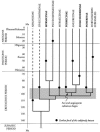The rise of the ants: a phylogenetic and ecological explanation
- PMID: 15899976
- PMCID: PMC1140440
- DOI: 10.1073/pnas.0502264102
The rise of the ants: a phylogenetic and ecological explanation
Abstract
In the past two decades, studies of anatomy, behavior, and, most recently, DNA sequences have clarified the phylogeny of the ants at the subfamily and generic levels. In addition, a rich new harvest of Cretaceous and Paleogene fossils has helped to date the major evolutionary radiations. We collate this information and then add data from the natural history of the modern fauna to sketch a history of major ecological adaptations at the subfamily level. The key events appear to have been, first, a mid-Cretaceous initial radiation in forest ground litter and soil coincident with the rise of the angiosperms (flowering plants), then a Paleogene advance to ecological dominance in concert with that of the angiosperms in tropical forests, and, finally, an expansion of some of the lineages, aided by changes in diet away from dependence on predation, upward into the canopy, and outward into more xeric environments.
Figures

Similar articles
-
Fossil evidence for the early ant evolution.Naturwissenschaften. 2008 Feb;95(2):85-90. doi: 10.1007/s00114-007-0301-8. Epub 2007 Sep 19. Naturwissenschaften. 2008. PMID: 17891532 Review.
-
Phylogeny of the ants: diversification in the age of angiosperms.Science. 2006 Apr 7;312(5770):101-4. doi: 10.1126/science.1124891. Science. 2006. PMID: 16601190
-
Explosive radiation of Malpighiales supports a mid-cretaceous origin of modern tropical rain forests.Am Nat. 2005 Mar;165(3):E36-65. doi: 10.1086/428296. Epub 2005 Feb 1. Am Nat. 2005. PMID: 15729659
-
A revised and dated phylogeny of cobweb spiders (Araneae, Araneoidea, Theridiidae): A predatory Cretaceous lineage diversifying in the era of the ants (Hymenoptera, Formicidae).Mol Phylogenet Evol. 2016 Jan;94(Pt B):658-675. doi: 10.1016/j.ympev.2015.09.023. Epub 2015 Oct 8. Mol Phylogenet Evol. 2016. PMID: 26454029
-
Ecological radiations of insects in the Mesozoic.Trends Ecol Evol. 2022 Jun;37(6):529-540. doi: 10.1016/j.tree.2022.02.007. Epub 2022 Mar 11. Trends Ecol Evol. 2022. PMID: 35287981 Review.
Cited by
-
Adaptive trade-offs between vertebrate defence and insect predation drive Amazonian ant venom evolution.Proc Biol Sci. 2024 Nov;291(2035):20242184. doi: 10.1098/rspb.2024.2184. Epub 2024 Nov 20. Proc Biol Sci. 2024. PMID: 39561794
-
Long-term strict ant-plant mutualism identity characterises growth rate and leaf shearing resistance of an Amazonian myrmecophyte.Sci Rep. 2024 Aug 1;14(1):17813. doi: 10.1038/s41598-024-67140-4. Sci Rep. 2024. PMID: 39090121 Free PMC article.
-
Convergent evolution of fern nectaries facilitated independent recruitment of ant-bodyguards from flowering plants.Nat Commun. 2024 May 24;15(1):4392. doi: 10.1038/s41467-024-48646-x. Nat Commun. 2024. PMID: 38789437 Free PMC article.
-
The Angiosperm Terrestrial Revolution buffered ants against extinction.Proc Natl Acad Sci U S A. 2024 Mar 26;121(13):e2317795121. doi: 10.1073/pnas.2317795121. Epub 2024 Mar 11. Proc Natl Acad Sci U S A. 2024. PMID: 38466878 Free PMC article.
-
Novel tRNA Gene Rearrangements in the Mitochondrial Genomes of Poneroid Ants and Phylogenetic Implication of Paraponerinae (Hymenoptera: Formicidae).Life (Basel). 2023 Oct 16;13(10):2068. doi: 10.3390/life13102068. Life (Basel). 2023. PMID: 37895449 Free PMC article.
References
-
- Grimaldi, D. (2000) Proc. XXI Int. Congr. Entomol. 1, xix–xxvii.
-
- Wilson, E. O. (1990) Success and Dominance in Ecosystems: The Case of the Social Insects (Ecology Institute, Oldendorf/Luhe, Germany).
-
- Fittkau, E. J. & Klinge, H. (1973) Biotropica 5, 2–14.
-
- Bolton, B. (2003) Mem. Am. Entomol. Inst. 71, 1–103.
-
- Wilson, E. O., Carpenter, F. M. & Brown, W. L. (1967) Science 157, 1038–1040. - PubMed
Publication types
MeSH terms
LinkOut - more resources
Full Text Sources
Miscellaneous


